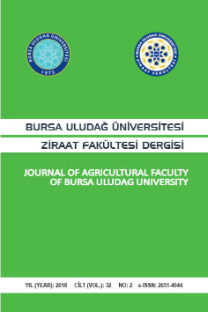Levels of zinc, copper and magnesium in sheep with toxoplasmosis
bakır, koyun, Toxoplasma gondii, kan kimyası, çinko, yün, toksoplazmoz, magnezyum
Toxoplazmozis' li koyunlarda çinko, bakır ve magnezyum düzeyleri
copper, sheep, Toxoplasma gondii, blood chemistry, zinc, wool, toxoplasmosis, magnesium,
___
1. BHAGAVAN NV. Medical Biochemistry, 2nd ed., Jones&Bartlett, Bostan, USA. 1992. 2. BEISEL R.W. Trace elements in infectiosis processes. Med Clin North Am 1976; 60: 831-849. 3. BUXTON D. Toxoplasmosis. The Practioner 1990; 234: 42-44. 4. ÇAMAŞ H, BİLDİK A, GÜLSEVER F. Investigation of some trace elements (Cu, Mo, Zn, Co, Mn) and sulphate in soil, grass and sheep’s blood. Y.Y.Ü. Vet Fak Derg 1999; 10(1-2): 87-91. 5. DINARELLO AC. Interleukin I and the patogenesis of acute-phase response. N. Engl S. Med 1984; 311: 1413-1418. 6. DUBEY PJ. Status of Toxoplasmosis in sheep and goats in the United States6. J. Am Vet Med Assoc 1990; 196: 259-262. 7. EL-KHOLY SM, GAB-ALLAH AM, EL-SHIMI, S. Zinc and copper status in children with bronchial asthma and atopic dermatitis. J. Egypt Pub Health Assoc 1990; 65(5-6): 557-668. 8. FRENKEL KJ, DUBEY PJ, MILLER LN. Toxoplasma gondii in cats: Fecal stages identified as coccidian oocysts. Science 1970; 167: 893-896. 9. FRENKEL KJ. Physiopathology of Toxoplasmosis. Parasitol 1988; 4; 273-278. 10. GRIFFITHS ED, WHARTON CD. Studies of the electron transport system. J. Biol Chem 1961; 236: 1850-1856. 11. KANEKO JJ, HARVEY JW, BRUSS ML. Clinical Biochemistry of Domestic Animals. 5th ed. Academic Press, London., 1997; 890-891. 12. KARGIN KIRAL F, SEYREK K, BILDIK A, AYPAK S. Determination of the Levels of Zinc, Copper, Calcium, Phosphor and Magnesium of Chios Ewes in the Aydın Region. Turk J Vet Anim Sci In press. 13. KLASSING CK. Effect of inflamatory agents and Interleukin I on iron and zinc metabolism. Am J. Physiol 1984; 247: 901-904. 14. KLASSING CK. Nutritional aspects of leukocytic cytokins. J. Nut 1988; 118: 1435-1443. 15. KURT D, DENLI O, KANAY Z, GÜZEL C, CEYLAN K. An investigation of the copper (Cu), Zinc (Zn) and Selenium (Se) levels of blood serum and the Cu and Zn levels of wool of Akkaraman Ewes in the Diyarbakır region. Turk. J. Vet. Met. Anim. Sci 2001; 25: 431-436. 16. LEONARD A, GERBER GB, LEONARD F. Mutagenicity, carcinogenicity and teratogenicity of zinc. Mutat Res 1986; 168: 348-353. 17. MONTAYA JG. Laboratory diagnosis of Toxoplasma gondii infection and Toxoplasmosis. J. Infect Dis 2002; 185(15): 73-82. 18. O’DELL LB. Biochemistry and physiology of copper in vertebrates. In: Prasad, A.S. (ed.) Trace elements in human health and diseases, Academic Press, New York, 1976; pp 391-413. 19. PAŞA S, KARGIN KIRAL F, BILDIK A, SEYREK K, OZBEL Y, OZENSOY S. Serum and hair levels of zinc and other elements in dogs with visceral leishmaniasis. Biol Trace Elem Res 2003; 94: 141-147. 20. RUSHTON B. Veterinary Laboratory Data. London. B.V.A. Publications. 1984; pp: 1-55. 21. SABIN AB, FELDMAN HA. Dyes as microchemical indicators of a new immunity phenomenn affecting a protozoon parasite (Toxoplasma). Science 1948; 108: 660-663. 22. SONNERBORG A, CARLIN G, AKERLUND B. Increased production of malondialdehyde in patients with HIV infection. Scand J. Infect Dis 1988; 20(3): 287-290. 23. SVENSON KLG, HALLGREN R, JOHANSEN E, LINDTH U. Reduced zinc in peripheral blood cells from patients with inflammatory connective tissue disease. Inflammation 1985; 9: 189-199. 24. TAŞÇI S, SENGIL AZ, ALTINDIS M, ARISOY K. The effect of zinc supplementation in experimentally induced Toxoplasma gondii infection. J. Egypt Soc Parasitol 1995; 25: 745-755. 25. TENTER AM, HECKEROTH AR, WEISS LM. Toxoplasma gondii: from animals to humans. Int J. Parasitol 2000; 30(12-13): 1217-1258. 26. WELLINGHAUSEN N, JOCHLE W, REUTER S, FLEGEL WA, GRUNERT A, KERN P. Zinc status in patients with alveolar echinococcosis is related to disease progression. Parasite Immunol 1999; 21(5): 237-241. 27. YAZAR S, KILIÇ E, SARAYMEN R. Changes of total content of magnesium and zinc status in patients with chronic toxoplasmosis. Biol Trace Elem Res 2003; 92: 11-15.- ISSN: 1301-3173
- Yayın Aralığı: 2
- Başlangıç: 1981
- Yayıncı: Ahmet Akkoç
Tavuk ve horozların gelişme sürecinde hipofiz bezi pars distalisinin histolojik yönden incelenmesi
Tarımsal ve hayvansal ürünlerde modern biyoteknoloji ve organik üretim
Prediction of albumen weight, yolk weight, and shell weight as egg weight in japanese quail eggs
Köpeklerde farklı siklus evrelerindeki vaginal bakteriyel floranın incelenmesi
ÜLGEN GÜNAY, AYTEKİN GÜNAY, Mihriban ÜLGEN, A. Ebru ÖZEL
Atlarda protozoal myeloensefalit
İBRAHİM ŞEKER, SELİM KUL, Metin BAYRAKTAR, Fikriye EKMEN, Yıldırım ÖZGE
METİN PETEK, Ş.Şule GEZEN, FAZLI ALPAY
CENK AYDIN, Engin KENNERMAN, NURTEN GALİP, Murat YALÇIN, Füsun AK, Cüneyt KAYAALP
Cryptosporidium parvum' un buluşmasında su ve gıdaların rolü
